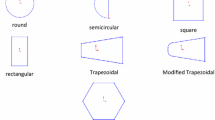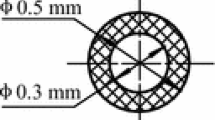Abstract
Stenter machines are used for drying fabrics in the textile industry and have a heater, injection duct system, and fans inside a chamber. The injection duct system has ducts and air-injecting holes. Plane-type injection duct systems were investigated to obtain uniform airflow at the air-injecting holes. The flowfield of the injection duct systems was computed using ANSYS CFX with different heights of the duct end and different shapes for the air-injecting holes. There was a high mass flow rate at the air-injecting holes and high airflow circulation inside both plane-type and mountain-type ducts at the ends. The height of the duct end was varied between 40 mm and 160 mm. The injection duct systems were analyzed with four different shapes of air-injecting holes. The circular and elliptical holes had lower standard deviations of the mass flow rate than other shapes. Relatively uniform mass flow rates were obtained in the plane-type and mountain-type duct systems when the height of the duct end was 40 mm and the shape of the air-injecting holes was circular or elliptical. The developed injection duct systems were improved by obtaining a uniform mass flow rate at the air-injecting holes. A stenter prototype was fabricated with the developed injection duct system to confirm the numerical results. The developed injection duct system had better performance than the original system.
Similar content being viewed by others
References
W. F. Beckwith and J. N. Beard, Scheme to assist in the evaluation of tenter frame dryer performance, Journal of Engineering for Industry-transactions of the ASME, 101 (1979) 80–84.
X. Li, Process optimization of dryers/tenters in the textile industry, Master Thesis(2004).
W. H. Henbrank and W. C. Brown, Means to reduce fuel requirements of textile finishing tenter dryers, National Technical Conference of AATCC, New Orleans(1974) 285.
Project report, Optimal design of the duct and nozzle of energy saving Tenter, Ministry of Knowledge Economy Korea Textile Machinery Institution(2008).
P. W. Gibson and M. Charmchi, Modeling convection/ diffusion process in porous textiles with inclusion of humidity-dependent air permeability, Int. Comm. Heat Mass Transfer, 24 (1997) 709–724.
S. Whitaker, Theory of Drying in Porous Media, Advances in Heat Transfer, 13 Academic Press, New York(1977) 119–203.
ANSYS CFX, ANSYS Workbench, ICEM-CFD, CFX-Pre, CFX-Solver, CFX-Post User’s Manual(2009).
M. Juraeva, K. J. Ryu, S. H. Jeong and D. J. Song, A computational analysis of the airflow in a twin-track subway tunnel with a sliding-curtain to improve ventilation performance, Journal of Mechanical Science and Technology, 27 (2013) 2359–2365.
F. R. Menter, Two-equation eddy-viscosity turbulence models for engineering applications, AIAA-Journal, 32 (1994) 269–289.
J. Tu., G. H. Yeoh and C. Liu, Computational Fluid Dynamics, A Practical approach, Butterworth-Heinemann is an imprint of Elsevier(2008).
D. C. Wilcox, Comparison of two equation turbulence models for boundary layers with pressure gradient, AIAA Journal, 31 (9) (1993) 1414–1421.
D. W. Lyons and C. T. Vollers, The drying of fibrous materials, Textile Research Journal, 31 (1971) 490.
www.ewagt.com.
Final report, Design optimization of flow paths and nozzle geometry of Tenter machine to save energy, Korea Textile Machinery Institution(2008).
Author information
Authors and Affiliations
Corresponding author
Additional information
Both authors contributed equally to this work as co-first author.
Recommended by Associate Editor Donghyun You
Dong Joo Song is a Professor of School of Mechanical Engineering, Yeungnam University, Gyeongsan, Korea. He received his doctor degree in aerospace engineering from Virginia Tech.
Rights and permissions
About this article
Cite this article
Juraeva, M., Ryu, K.J. & Song, D.J. Optimum design of the injection duct system of a stenter machine. J Mech Sci Technol 31, 2279–2285 (2017). https://doi.org/10.1007/s12206-017-0424-6
Received:
Revised:
Accepted:
Published:
Issue Date:
DOI: https://doi.org/10.1007/s12206-017-0424-6




